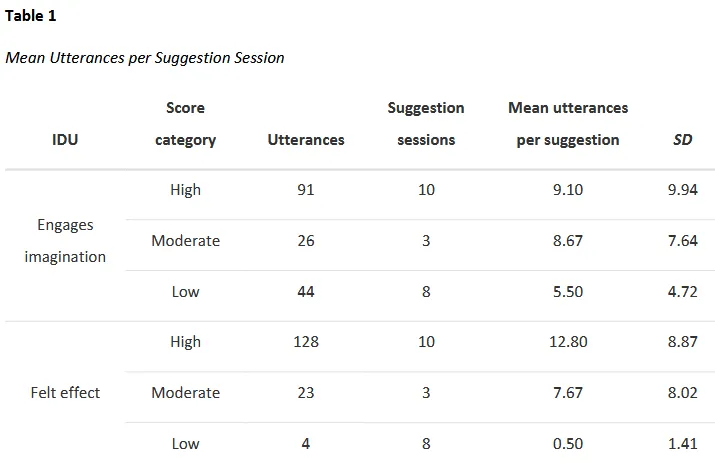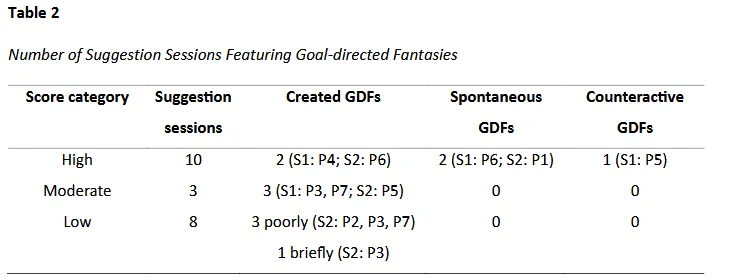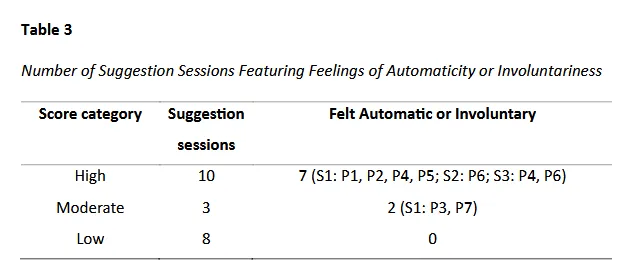The Experience of Responding to Imaginative Suggestions: A Micro-phenomenological Interview Pilot Study
https://osf.io/preprints/osf/vsdn9_v2
Abstract
Section titled “Abstract”- A 2 minute technique for investigating phenomena.
- A pilot study - only 13 total participants.
- Three hypothesis, made for further study:
- High responses rarely involved intentional Goal Directed Fantasies (GDFs), mediums almost always involved intentional GDFs.
- Lows did not involve reports of active sabotage.
- Highs and mids don’t appear to be aware they’re generating the suggested behavior and cognitions.
The Experience of Responding to Imaginative Suggestions: Micro-phenomenological Interviews
Section titled “The Experience of Responding to Imaginative Suggestions: Micro-phenomenological Interviews”We still don’t know the mechanics behind self deception (ala Gorassini) or modifying higher order thoughts (ala Cold Control)
Where Lynn found active engagement helped response - wouldn’t that make responses feel voluntary? One explanation is the degree of absorption in the GDF. Even if we instruct people how to respond to a GDF, we still see different responses and highs and lows. So, they’d like to investigate the differences in how imagination is approached.
Cognitive skills training interventions (probably like the CSTP) have been successful in the past. Past studies were dedicated to testing a theory - this one is dedicated to analyzing the experiences of the participants to find correlation and better techniques.
They used their own take on the micro-phenomenological interview to dig in to participant’s responses. (Unfortunately, I’m a scrub and don’t have an OSF account, so I’ll have to see what I can do to get access, if the authors are even cool with that.) It’s designed to quickly find out what participants are aware of, what they’re trying to do, what they can remember, and what they’re trying to respond to. While internal reports are often biased, there’s data that can and should be explained, and can be used for theory generation.
Most studies focus on the overall response of the participant. Instead, this looks at the per-phenomena response.
Procedure
Section titled “Procedure”Procedure is linked at https://osf.io/ezm5x/, but requires an OSF account and likely access. The exercises were:
- Modified hands coming together (warmup, not analyzed)
- Hands coming together (again, but slightly different)
- Hands stuck together
- Happy birthday auditory hallucination
- All suggestions had the participant close their eyes.
- Doesn’t look like there’s any surprises in the suggestion style.
- Participants were asked to rate their experiences on the Likert scale. (0 - no effect. 5 - strong, as if real.)
They recorded their responses, and then did a micro-phenomenological interview.
- Participant utterances were clustered by moment.
- The clusters were broken up into inciphent diachronic units (IDU.) I’m inferring from the paper this means things like… quoting the paper…
Moment delineations were identified through sub-phrases, such as “at the start”, “and then”, “and that’s when”, and “when you said”, among others, that indicated the order of at least two utterances.
- Those clustered moments were broken up into a “synchronic analysis spreadsheet.” They were split up into themes as an abstraction. Inside those themes, they broke them up into incipient synchronic units (ISUs.)
Results
Section titled “Results”They did a “diachronic analysis” per suggestion.
The generic diachronic analysis revealed that within each suggestion, the participants appeared to report experiences that were chronologically quite similar. In general, they may have had some initial thoughts, were then likely to have engaged their imagination, then usually felt some kind of effect. The participants with low scores did not appear to differ chronologically in any great capacity (other than whether they felt the effect) from those with moderate or high scores. There was no evidence, in the generic diachronic analysis, of participants with low scores actively sabotaging their experience in order to prevent the suggested effects; in specific terms, the responses from those with low scores did not appear to include extra phases that would be detrimental to their response.
People that talked less about their experience experienced less (reasonably obvious.) However, low responses talked less about how many times they tried to imagine the suggestions.

Interestingly, they categorized qualities of the GDFs - EG:
- “I imagined” would be marked as intentional.
- “I saw,” “an image of X appeared” would be spontaneous. These only appeared in highs.
- There were poor GDFs. These appear to be subjectively analyzed. For instance, having your hands covered in honey would be unlikely to keep them truly stuck together.

Also - ‘automatic’ feeling responses had stronger effects.

Discussion
Section titled “Discussion”- People with low responses appeared to engage less with their imagination. Encouraging them to do more might help.
- Personal note: The happy birthday suggestion might have academic use in analysis but holy shit just put some damn white noise on in the background and suggest they hear the song deeply buried in the background.
- Most high responses didn’t involve (intentional) GDFs.
Ah, and the meat…
The data suggested four hypotheses:
- Moderate and high responders have more to say about engaging their imagination than low responders.
- High responders mostly do not report GDFs; moderate responders mostly do report GDFs; low responders do not report supportive GDFs with sufficient conviction.
- Low responders do not report actively sabotaging their response.
- Moderate and high responders do not appear aware that they were responsible for their behaviour and experience.
Phase 2
Section titled “Phase 2”They replicated phase 1 (mentioned above) to test the four hypothesis. Looks like when they rolled the dice they had more folks with the propensity to respond less on this round, but it didn’t prevent them from testing said hypotheses.
The found less support of hypothesis 1 (the lows were more talkative this time.) Hypothesis 2, 3, and 4 continued to find steady support. They noted their study was tiny, and all hypothesis are still worth investigation.
In summary, highs did not seem to use GDFs, and only a few reported spontaneous GDFs. There’s a few possibilities. There could be a problem with demand characteristics (unlikely,) they had spontaneous amnesia (unlikely,) or they were dissociated from their imaginings (which is just about as dubious.) The fourth (simpler) explanation is they just responded without GDFs, where lows and mediums benefit from intentional GDFs.
We might be able to take away from this paper that we can reach for GDFs as a crutch if a suggestion isn’t effective.
In principle this can be done without imagining the means for achieving that outcome: One just needs to intend the motor and cognitive actions required and not be aware of those intentions (intend the arm to rise; cf. Palfi et al., 2021). When people respond well, this seems to be what happens: The means is not imagined, just the outcome (see Comey & Kirsch, 1999). But convincing oneself that one is not intending the action may be helped in difficult cases by imagining one is not intending the action (Sheldrake & Dienes, 2024).